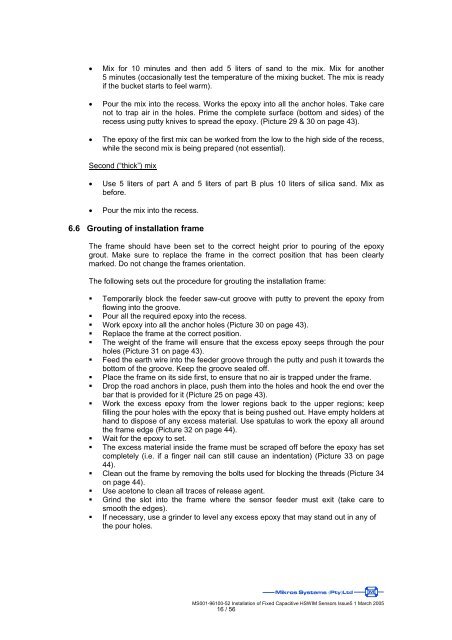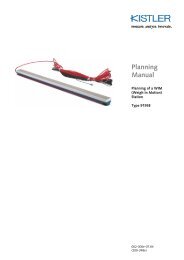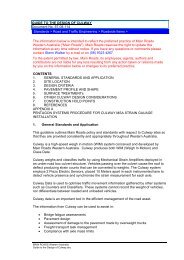Installation of Fixed Capacitive HSWIM Sensors
Installation of Fixed Capacitive HSWIM Sensors
Installation of Fixed Capacitive HSWIM Sensors
You also want an ePaper? Increase the reach of your titles
YUMPU automatically turns print PDFs into web optimized ePapers that Google loves.
• Mix for 10 minutes and then add 5 liters <strong>of</strong> sand to the mix. Mix for another<br />
5 minutes (occasionally test the temperature <strong>of</strong> the mixing bucket. The mix is ready<br />
if the bucket starts to feel warm).<br />
• Pour the mix into the recess. Works the epoxy into all the anchor holes. Take care<br />
not to trap air in the holes. Prime the complete surface (bottom and sides) <strong>of</strong> the<br />
recess using putty knives to spread the epoxy. (Picture 29 & 30 on page 43).<br />
• The epoxy <strong>of</strong> the first mix can be worked from the low to the high side <strong>of</strong> the recess,<br />
while the second mix is being prepared (not essential).<br />
Second (“thick”) mix<br />
• Use 5 liters <strong>of</strong> part A and 5 liters <strong>of</strong> part B plus 10 liters <strong>of</strong> silica sand. Mix as<br />
before.<br />
• Pour the mix into the recess.<br />
6.6 Grouting <strong>of</strong> installation frame<br />
The frame should have been set to the correct height prior to pouring <strong>of</strong> the epoxy<br />
grout. Make sure to replace the frame in the correct position that has been clearly<br />
marked. Do not change the frames orientation.<br />
The following sets out the procedure for grouting the installation frame:<br />
Temporarily block the feeder saw-cut groove with putty to prevent the epoxy from<br />
flowing into the groove.<br />
Pour all the required epoxy into the recess.<br />
Work epoxy into all the anchor holes (Picture 30 on page 43).<br />
Replace the frame at the correct position.<br />
The weight <strong>of</strong> the frame will ensure that the excess epoxy seeps through the pour<br />
holes (Picture 31 on page 43).<br />
Feed the earth wire into the feeder groove through the putty and push it towards the<br />
bottom <strong>of</strong> the groove. Keep the groove sealed <strong>of</strong>f.<br />
Place the frame on its side first, to ensure that no air is trapped under the frame.<br />
Drop the road anchors in place, push them into the holes and hook the end over the<br />
bar that is provided for it (Picture 25 on page 43).<br />
Work the excess epoxy from the lower regions back to the upper regions; keep<br />
filling the pour holes with the epoxy that is being pushed out. Have empty holders at<br />
hand to dispose <strong>of</strong> any excess material. Use spatulas to work the epoxy all around<br />
the frame edge (Picture 32 on page 44).<br />
Wait for the epoxy to set.<br />
The excess material inside the frame must be scraped <strong>of</strong>f before the epoxy has set<br />
completely (i.e. if a finger nail can still cause an indentation) (Picture 33 on page<br />
44).<br />
Clean out the frame by removing the bolts used for blocking the threads (Picture 34<br />
on page 44).<br />
Use acetone to clean all traces <strong>of</strong> release agent.<br />
Grind the slot into the frame where the sensor feeder must exit (take care to<br />
smooth the edges).<br />
If necessary, use a grinder to level any excess epoxy that may stand out in any <strong>of</strong><br />
the pour holes.<br />
MS001-96100-52 <strong>Installation</strong> <strong>of</strong> <strong>Fixed</strong> <strong>Capacitive</strong> <strong>HSWIM</strong> <strong>Sensors</strong> Issue5 1 March 2005<br />
16 / 56
















